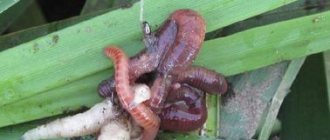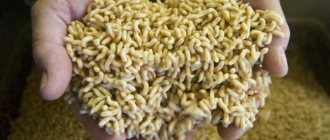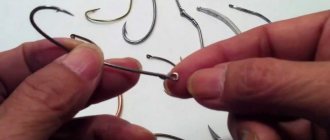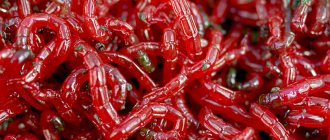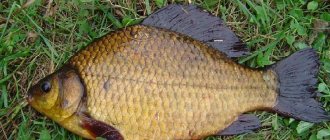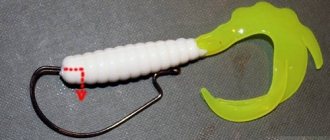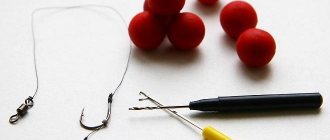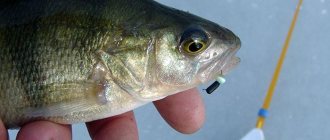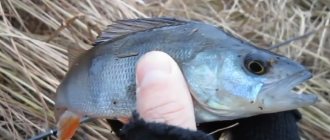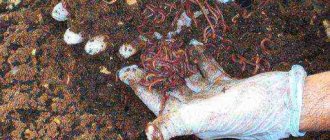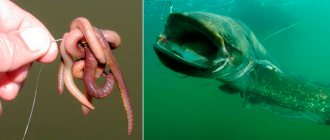Rules for baiting worms
There are three basic rules for worm baiting:
- It must be mounted in such a way that it remains mobile and alive , that is, attractive to fish;
- The worm and hook must be proportional, so the size of the bait is selected according to the size of the hook. This is necessary so that the fish does not break loose and the bait does not jump off;
- Each worm must be placed on the entire hook , since the fish with such a bait will swallow it whole.
For large individuals, you can attach several worms at once, as this will increase the chances of a positive catch. Piece baiting is used for small fish, but the catch is reduced due to loss of mobility. For this type of bait, you can use a combination of porridge in the bait.
Use this bait for:
- When fishing for crucian carp, red dung worms are suitable; until fishing, it is better to keep them in mint or herbs, which will allow them to obtain a tempting aroma for crucian carp
float tackle;
- spinning;
- jigs;
- donks;
- feeder
Each type of worm is used for a specific fish:
- Earthworms are used to catch carp ; they are pierced below the base of the head, after which the piercing gradually moves down to the tail, while the sting is securely hidden in the remains of the tail (four centimeters);
- Crawlers in bunch bait are used to catch catfish. Several fish are put on the hook in a loop through the middle of the body; with this type of puncture, small fish will not bite;
- Bream are caught using bunches of dung worms;
- When fishing for crucian carp, red dung worms are suitable, which are best kept in mint or herbs until fishing, which will allow them to obtain a tempting aroma for crucian carp. In this case, red dung worms are planted in small pieces.
The use of bait or lure also depends on the nature of fishing:
- when catching predatory fish, worms are combined with fish pieces or crawl parts;
- for non-predatory fish, the worm is combined with maggots, pearl barley or corn porridge.
The correct nozzle is distinguished by:
- The punctures begin at the base of the head;
- The hook is inserted under the skin. The base of the hook should be thin and short, preferably half the length of the bait. When the nozzle is fully inserted, the first puncture is made one and a half centimeters from the head. After the punctures are completed, the sting is hidden in the body of the worm, not reaching the tail, which dangles freely.
How to put a worm on a hook depending on the type of fish
The effectiveness of a bait such as a worm can be maximum, or it can drop to zero. The fact is that different types of fish react differently to bait. It is important to know how to properly attach a worm so that the fish wants to eat it.
Worm for crucian carp
Crucian carp will like dung or earthworm. It is important that its tip wriggles in the water, then large fish will be attracted. A bunch of small and medium-sized individuals is suitable. Small fish will bite on the pieces. There are several ways to put a worm on a crucian carp:
- over the head with a long tail left;
- by the tip. The worm should not exceed 1 cm. You can use part of it;
- through the entire body by threading it in several places.
You can soak the worm in mint or grass before fishing.
How to put a worm on a hook for bream
Bundles of worms are suitable for bream. Crawls are suitable for night fishing. Their body is pierced at the beginning and in the middle. You can use pieces by planting them in a chaotic manner. To prevent the bream from falling off, the worm is pierced lengthwise, going onto the fishing line. The tackle will increase the chances of a good catch. With any method, the sting should not look out.
How to attach a worm for carp
Regular earthworms will do. The bait is pierced in the head area, going down slightly. Several punctures are made, and the sting is hidden in the remainder of the tail. When fishing with a feeder or donk, a “sandwich” of bait is used. Before casting, the carp are fed dough or maggots. In addition to corn, a hair rig attached to the end can be attached to the mounted worm.
Mounting methods
There are a lot of mounting methods, but there is one feature that applies to any method:
- when catching small fish, the sting is completely closed;
- When catching large specimens, it is not necessary to completely cover the sting.
The rest of the process will be divided only by the number of worms.
The most common methods of placing a single worm on a hook are:
- Piercing along , with this method it is inserted along the entire length of the hook and part of the fishing line;
- Lump nozzle. The worm is divided into several parts, after which all its parts are put on the hook in order. This method is most often used in a simple fishing rod with a float;
- Eight. It is an attachment in which the worm forms loop shapes. Two different ends of the bait diverge in different directions, while the entire hook is occupied;
- Alive and squirming. With this method, the bait is put on the hook using several punctures; adjacent punctures have small gaps between them, which allow the bait to wriggle, which will attract large fish.
- Mounting on tackle. The individual is strung on the base of the longest hook, which has several stings. In this case, each sting remains open;
- Exit to the fishing line. The bait is pulled onto the fishing line fiber located above the hook base. This method is used when catching restless fish, since the hook is completely hidden, which allows the fish to swallow it whole and not break off.
Alive and wriggling - with this method, the bait is put on the hook using several punctures
General nozzle rules
You can't just poke a stinger through a worm and call it done. You need to follow some rules for this process.
- The bait should be strong, but gentle on the worm. After the puncture, he should remain alive and mobile. This is what attracts fish. Dung worms are not the most suitable option in this regard, because... after baiting they freeze on the hook.
- Easily torn specimens are threaded through the sting to prevent the possibility of slipping.
- The size of the bait should correspond to the thickness of the hook and the size of the fish's mouth. When catching large fish, you need to use a large worm or several small ones. Long worms are cut, but in such a way that each part then moves.
- By leaving a long tip of the worm, you can lure large fish, but small ones will bite.
- You need to place the worm on the entire hook, because... the fish will swallow it completely.
To increase the catch, you can attach a different type of bait to the worms. An important factor is the choice of rod for baiting worms. This could be a classic float rod, spinning rod, donka, or feeder.
Planting several worms
The beam nozzle has the following features:
- several worms are attached to the hook in different ways;
- after the beam shape is obtained, the tackle is slowly lowered into the water;
- This method is suitable for catching large fish.
With this type of fishing, it is necessary to ensure that the bunch is not immersed in the silt at the bottom of the reservoir. This is due to the fact that the “bundle” needs to be used only for float fishing.
Where to look for worms near a pond
It may happen that an amateur fisherman can come to a pond without bait, that is, without a worm. After all, it happens that hunters forget their gun, and this can happen to a fisherman. In this case, you can look for the worm directly near the pond, all you need is a shovel. If you still have a shovel at home, you can try to find it in shallow water using your hands. You can find out how this is done by watching the video. In any case, the river worm is no worse than the red dung worm.
How to get the Liman worm. Nereis.
Many fishermen claim that purchased worms are more attractive to fish than those obtained from the ground on their own. This may be true, but red dung worms are very difficult to replace with earthworms. Dung worms are more active and therefore attract fish better. And here a lot depends on how carefully the fisherman placed the worm on the hook.
Where to find worms
Worms prefer dark, damp places, such as:
- under logs;
- in manure;
- damp pits;
- garden humus.
In rural conditions, bait can be found quite easily, and in urban conditions, you can buy worms in the store.
Every angler should remember that bait must be taken in larger quantities than may be required. This is due to the fact that:
- You can catch any fish with a worm. This type of bait is universal;
- With a good bite, there may simply not be enough bait.
Useful tips
- Always take a small shovel with you when fishing. On the shore of a reservoir, you can use it to dig up worms, which are much more appetizing for crucian carp than those brought or bought in a store.
- Do not store the box of worms in the sun. Try to put it in the shade or hide it under a bush. Otherwise, 2-3 hours of exposure to the sun is enough to make the worms unsuitable even for hooking.
- To improve the bite, you can add a few drops of a natural-smelling flavoring (dill, garlic, etc.) to a jar of worms. Cottage cheese, crushed cherries or strawberries have proven themselves well, as they impart an unusual aroma and attract crucian carp.
- To keep the worms on the hook moving, you can dip the bait in garlic juice before casting the rig into the water. Sunflower or hemp oil will also work. This will definitely make them move actively.
- When catching small crucian carp or so-called “piglets”, you don’t have to leave the tail of the worm on the hook. Such a fish almost immediately tries to swallow the bait, so it will be enough to cover the tip with a small piece 1-1.5 cm long.
The video below will show you different ways to put a worm on a hook:
Storing the nozzle
You can store the nozzle in almost any container, the main thing is to follow a few rules:
- The container should have a lid with a small hole or holes through which fresh air will flow inside. Thanks to this, the attractiveness of the bait will remain for a long time;
- The lid must be closed tightly , as worms can crawl out;
- Before collecting the bait, the container is filled in advance with earth from the same place where the bait is taken. This is required so that you can fish with a fresh worm.
Without following these rules, you can lose worms, or they will dry out (lose their attractiveness), and this will affect the catch.
Blitz tips
To properly use worms as bait, there are several recommendations that will help you get a good catch:
- Before the bait itself, it is advisable to dip the worm in sunflower or hemp oil, so that when fishing there will be a small cloud near it that attracts fish
If there are no worms, you can use a special bait in the form of them. She is almost the same in appearance, which allows her to look attractive to fish;
- Storage in tins or cans is not recommended , as the bait acquires an odor and becomes less attractive to fish;
- Each worm has its own type , so storage requires specific separation into containers;
- A large number of individuals can only be stored in a large container with soil;
- When baiting several hooks, you can use one worm, it will just need a large size , and it can be pierced along the entire length of the body, so that one hook is at the head, the second in the middle, and the third pierces the end of the worm;
- When storing worms in soil containers for freshness, you can add a few drops of tea every day;
- The soil for worms is preferably taken from their habitats;
- Before the bait itself, it is advisable to dip the worm in sunflower or hemp oil, so that when fishing there will be a small cloud near it that attracts fish. You can also do this with garlic juice, which will force the individual to be more active, which will attract fish;
- They are usually caught with worms at the very bottom surface. This is due to the fact that there the fish can more often find it, since in the middle and upper water layer the fish will only react to the moving bait. In addition, the middle water layer has a special feature for fishing in that fishing with a worm is mainly done in the current;
- If the nozzle lies on the bottom, it will need to be pulled up periodically. This will attract fish;
- If the bait has been in the water for a long time , then it is advisable to change it.
- When using a worm as bait, you can roll it in clay or soil. This is done in the absence of special liquids, such as oil. The water in the area where the bait is located will be a little cloudy, which will make the bait more attractive to the fish. Most often, fine clay is used for such cases;
- When catching large species of fish and using a bunch bait, the fishing line fiber must be strong and dense, since the base of the hook will not allow the fish to break off.
Effective methods of baiting a worm when fishing for crucian carp
Most fishermen are accustomed to using only one method of threading worms onto a hook, which is not entirely correct. On a particular body of water, another method of attaching bait may be effective. This is explained by the different habits and preferences of the fish, the bottom topography, the depth in a particular fishing location, and much more. etc.
Therefore, we will tell you about five main methods that have proven themselves to be the best:
- The most common is “stocking”. The worm is pierced from the front and passed along the entire hook. In this case, you can leave a small part at the eye itself, which will move and make the bait more noticeable to the fish. Attaching a worm in this way is quite simple. The only caveat is that with every bite or even cast the hook tip will be exposed. You will have to regularly adjust the nozzle.
- An interesting option is “zigzag”. The worm is pierced in the front part, then after a few millimeters the sting comes out through and pierces the body of the invertebrate a little further. This action is repeated until a short end remains covering the tip. Thus, the worm looks more natural and appetizing to the fish itself.
- The worm is placed on the hook from the side of the body towards its “head”. It turns out that most of the animal bait remains free. It actively wriggles and becomes a tasty prey for crucian carp. This method is especially effective when fishing in muddy water.
- The best way to successfully catch crucian carp is to attach a worm to the hook through the middle. Thus, the fish can begin to swallow the bait from either end, and the invertebrate itself is practically not injured. The main thing is to use durable types of worms - Californian, dung, iron ore, etc.
- “We put them in a row.” If the worms are small, then you can string several invertebrates at once. The same as maggots, piercing each body closer to the front or strictly in the middle. This method is effective when the bite is weak, as well as on reservoirs with a silted bottom and large vegetation, where it will be easier for crucian carp to notice the bait.
- Some people prefer to catch crucian carp using the so-called “bundle”. That is, several rather large worms are attached to the hook at once. Or one breaks into pieces, which are strung perpendicular to the length of the entire forend. In our opinion, this is not entirely rational when catching such fish. Even a large crucian carp will not be able to swallow such a ball. If you use this technique, then only when catching trophy specimens weighing about 2 kg.
- The same applies to the method called “ring”. With it, the worm is pierced from the front. Then the sting is brought out approximately in the middle and reinserted from the tail. It turns out to be a kind of ring. Effective if you want to specifically cut off any bites of small fish and crucian carp smaller than the palm of your hand.
